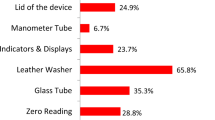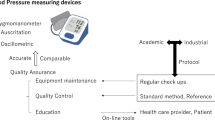Abstract
Objectives: To assess the condition, accuracy and safety of mercury and anaeroid sphygmomanometers in use in general practice and to pilot a scheme for sphygmomanometer maintenance within the district.
Design: Instruments were checked on site according to set protocols which related to established guidelines and standards and data were entered into a specially designed database. Mercury sphygmomanometers were removed to the laboratory for servicing. Practices received written feedback on the condition of each instrument checked, repairs undertaken and advice, where necessary, for further work required. Participant views on the scheme were sought.
Materials and methods: A total of 472 instruments (75.4% mercury) located in 86 general practices (87.8% of practices participated) in a health district in the West Midlands. Instruments were checked against 28 (mercury) and 25 (anaeroid) quality standards and (for mercury instruments) against British Hypertension Society guidelines.
Results: 69.1% of mercury and 95.7% of anaeroid instruments checked, had no service records. Of the remainder, only 29 mercury (8.1%) and one anaeroid (0.9%) had a record of a check or service within the previous 12 months. None of the instruments met all of the relevant quality standards and 14 (3.9%) mercury and seven (6.1%) anaeroid instruments met less than half. A large proportion of mercury sphygmomanometers tested had defects likely to affect recommended measurement technique. Only two-thirds were accurate at all pressure levels tested. Only 38.8% of anaeroid instruments were accurate at all test pressure levels.
Conclusions: The level of defects noted could have an impact on diagnosis and monitoring of hypertension.
This is a preview of subscription content, access via your institution
Access options
Subscribe to this journal
Receive 12 digital issues and online access to articles
$119.00 per year
only $9.92 per issue
Buy this article
- Purchase on Springer Link
- Instant access to full article PDF
Prices may be subject to local taxes which are calculated during checkout
Similar content being viewed by others
References
Burke MJ, Towers HM, O’Malley K Sphygmomanometers in hospital and family practice: problems and recommendations Br Med J 1982 285 469–471
Petrie JC, O’Brien ET, Littler WA, de Swiet M Recommendations on blood pressue measurement Br Med J 1986 293 611–615
Bailey RH, Bauer JH A review of common errors in the indirect measurement of blood pressure: sphygmomanometry Arch Int Med 1993 153 2741–2748
British Standards Institute BS:2743:1990. Specification of Aneroid and Mercury Non-automated Sphygmomanometers British Standards Institute: London 1990
Markandu ND, Whitcher F, Arnold A, Carney C The mercury sphygmomanometer should be abandoned before it is proscribed J Hum Hypertens 2000 14 31–36
Beevers M, Morgan HEG An audit of blood pressure measurement in two teaching hospitals J Hum Hypertens 1997 7 98
Department of Health National Service Framework for Coronary Heart Disease. DoH: London 2000
Acknowledgements
The project team wishes to acknowledge the support of North Staffordshire Health Authority in funding this work and are grateful to the participating practices for their time in completing questionnaires. Thanks are also due to Sarah Stewart for patiently retyping drafts of this paper.
Author information
Authors and Affiliations
Corresponding author
Rights and permissions
About this article
Cite this article
Knight, T., Leech, F., Jones, A. et al. Sphygmomanometers in use in general practice: an overlooked aspect of quality in patient care. J Hum Hypertens 15, 681–684 (2001). https://doi.org/10.1038/sj.jhh.1001251
Published:
Issue Date:
DOI: https://doi.org/10.1038/sj.jhh.1001251
Keywords
This article is cited by
-
Results of a project to calibrate mercury sphygmomanometer blood pressure-measuring devices in Egypt
Journal of Human Hypertension (2021)
-
From mercury sphygmomanometer to electric device on blood pressure measurement: correspondence of Minamata Convention on Mercury
Hypertension Research (2016)
-
Calibration accuracy of hospital-based non-invasive blood pressure measuring devices
Journal of Human Hypertension (2010)
-
Automated Sphygmomanometers Should Not Replace Manual Ones, Based on Current Evidence
American Journal of Hypertension (2008)



